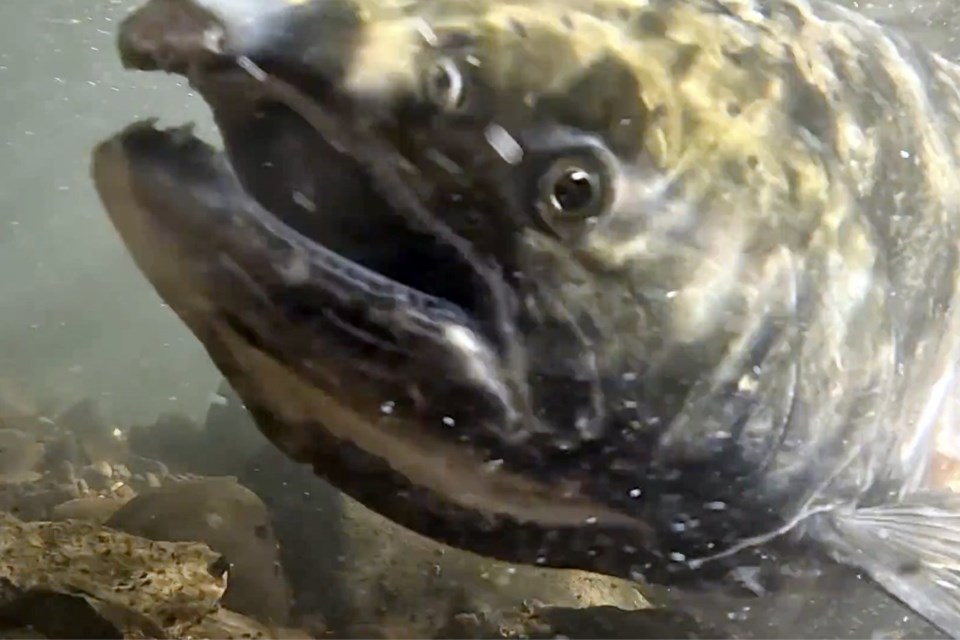A giant female Chinook salmon flips on her side in the shallow water and wriggles wildly, using her tail to carve out a nest in the riverbed as her body glistens in the sunlight. In another moment, males butt into each other as they jockey for a good position to fertilize eggs.
These are scenes local tribes have dreamed of seeing for decades as they fought to bring down four hydroelectric dams blocking passage for struggling salmon along more than 400 miles (644 kilometers) of the Klamath River and its tributaries along the Oregon-California border.
Now, less than a month after those dams came down in the largest dam removal project in U.S. history, salmon are once more returning to spawn in cool creeks that have been cut off to them for generations. Video shot by the Yurok Tribe show that hundreds of salmon have made it to tributaries between the former Iron Gate and Copco dams, a hopeful sign for the .
“Seeing salmon spawning above the former dams fills my heart,” said Joseph L. James, chairman of the Yurok Tribe. “Our salmon are coming home. Klamath Basin tribes fought for decades to make this day a reality because our future generations deserve to inherit a healthier river from the headwaters to the sea.”
The Klamath River flows from its headwaters in southern Oregon and across the mountainous forests of northern California before it reaches the Pacific Ocean.
The completion of the hydroelectric dam removal project on Oct. 2 marked a . Through protests, testimony and lawsuits, the tribes showcased the environmental devastation caused by the dams, especially to salmon, which were cut off from their historic habitat and dying in alarming numbers because of poor water-quality.
There have been lower concentrations of harmful algae blooms since the dam removal, Toz Soto, fisheries program manager with the Karuk Tribe, said during a press conference after the dams came down. In October, the water temperature during the day was an average of 8 degrees Celsius (14 degrees Fahrenheit) cooler compared to the same month over the last nine years, according to the Klamath River Renewal Corporation, the nonprofit entity created to oversee the project.
“All in all, the fish that came up this year were really healthy,” Soto said. “I didn’t see fish with bacterial infections and things like that, so water temperature’s already having an impact on the fishes’ health.”
The number of salmon that have quickly made it into previously inaccessible tributaries has also been encouraging. Experts have counted 42 redds, or salmon egg nests, and have tallied as many as 115 Chinook salmon in one day in Spencer Creek, which is above the former J.C. Boyle dam, the furthest upstream of the four removed dams, said Mark Hereford with the Oregon Department of Fish and Wildlife.
“They’re showing us where the good habitat is; they’re showing us where there’s a lack of habitat,” said Barry McCovey Jr, director of the Yurok Tribal Fisheries department. “So we can use these fish to inform us as river managers, as scientists, where restoration needs to take place.”
Power company PacifiCorp built to generate electricity between 1918 and 1962. But the structures halted the natural flow of the waterway that was once known as the third-largest salmon-producing river on the West Coast. They disrupted the lifecycle of the region’s salmon, which spend most of their life in the Pacific Ocean but return to the chilly mountain streams to lay eggs.
At the same time, the dams only produced a fraction of PacifiCorp’s energy at full capacity, enough to power about 70,000 homes. They also didn’t provide irrigation, drinking water or flood control, according to Klamath River Renewal Corporation.
McCovey said the return of so many salmon happened faster than he had expected and makes him hopeful for the future of the river.
“Out of all the milestones that we’ve had, this one to me is the most significant," he said. “It feels like catharsis. It feels like the right path.”
___
Associated Press reporter Sophie Austin contributed to this report.
Hallie Golden, The Associated Press




